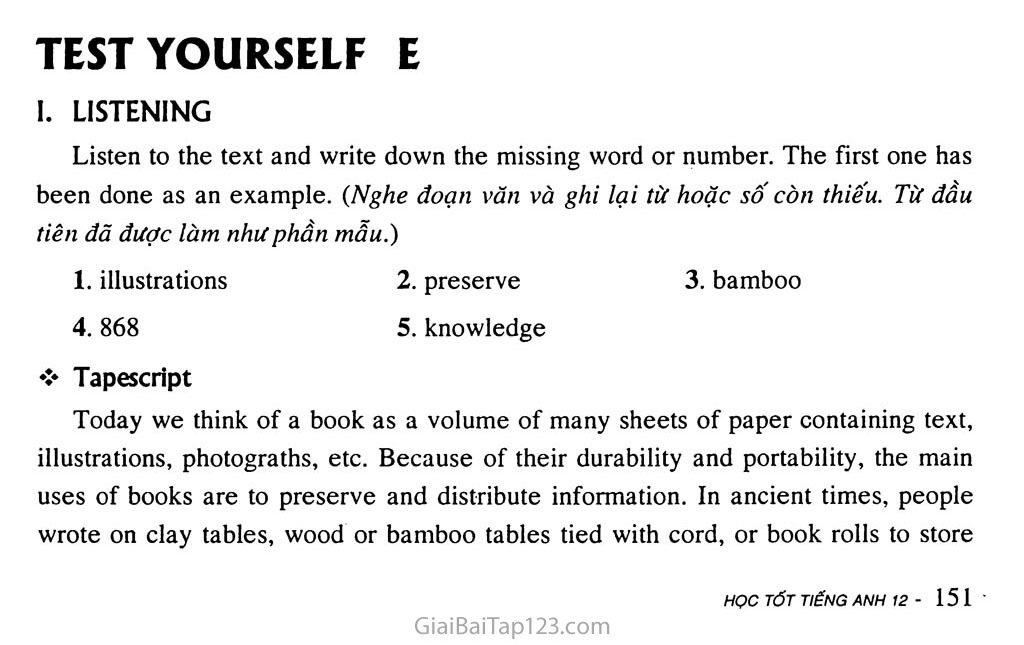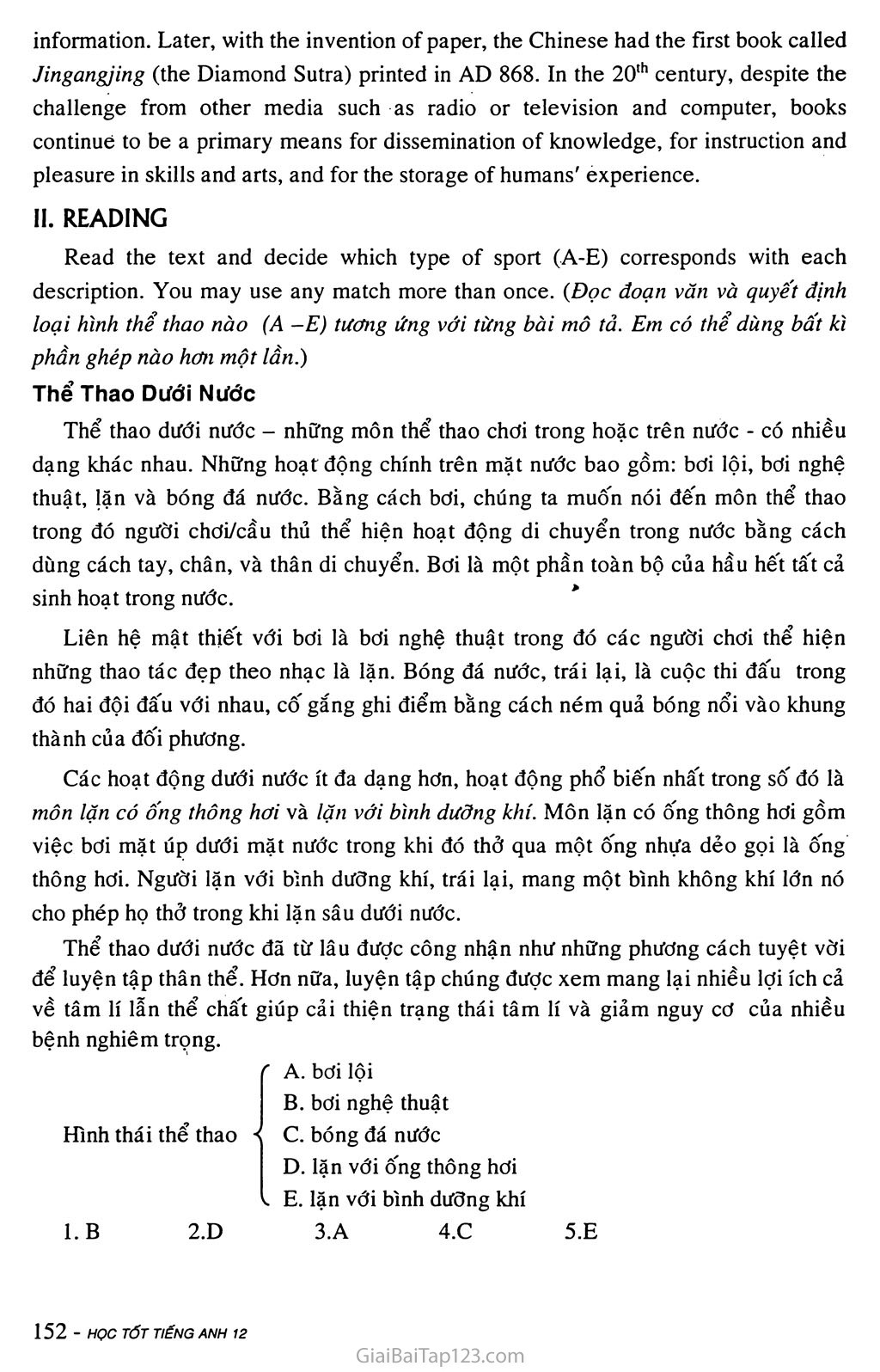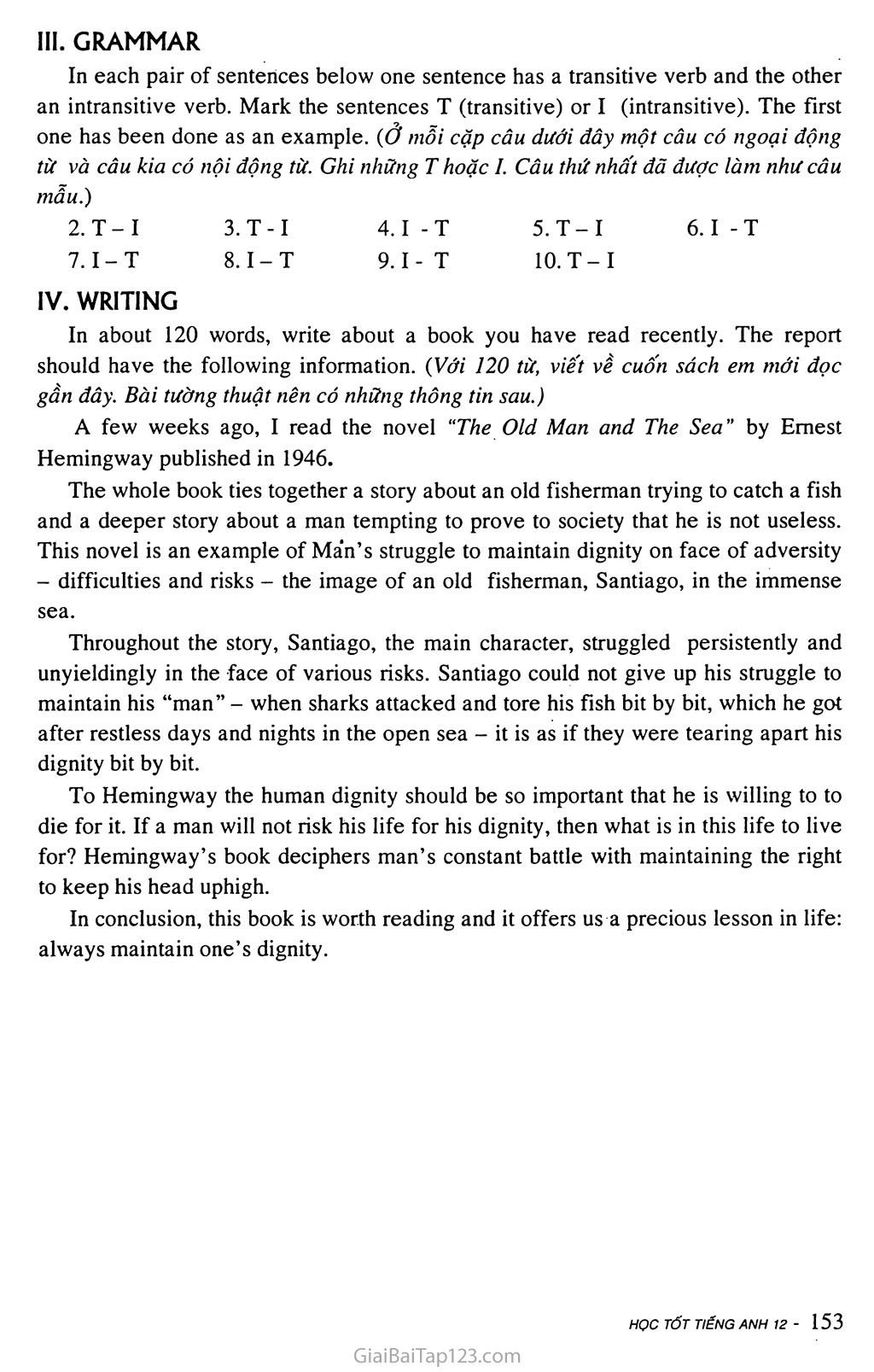Giải tiếng Anh lớp 12 Test Yourself E
TEST YOURSELF E
I. LISTENING
Listen to the text and write down the missing word or number. The first one has been done as an example. {Nghe đoạn văn và ghi lại từ hoặc số còn thiếu. Từ đầu tiên đã được làm như phần mẫu.)
1. illustrations 2. preserve 3. bamboo
868 5. knowledge
❖ Tapescript
Today we think of a book as a volume of many sheets of paper containing text, illustrations, photograths, etc. Because of their durability and portability, the main uses of books are to preserve and distribute information. In ancient times, people wrote on clay tables, wood or bamboo tables tied with cord, or book rolls to store
information. Later, with the invention of paper, the Chinese had the first book called Jingangjing (the Diamond Sutra) printed in AD 868. In the 20th century, despite the challenge from other media such as radio or television and computer, books continue to be a primary means for dissemination of knowledge, for instruction and pleasure in skills and arts, and for the storage of humans' experience.
READING
Read the text and decide which type of sport (A-E) corresponds with each description. You may use any match more than once. {Đọc đoạn văn và quyết định loại hình thể thao nào (A -E) tương ứng với từng bài mô tả. Em có thể dùng bất kì phần ghép nào hơn một lần.)
Thể Thao Dưới Nước
Thể thao dưới nước - những môn thể thao chơi trong hoặc trên nước - có nhiều dạng khác nhau. Những hoạt động chính trên mặt nước bao gồm: bơi lội, bơi nghệ thuật, Ịặn và bóng đá nước. Bằng cách bơi, chúng ta muôn nói đến môn thể thao trong đó người chơi/cầu thủ thể hiện hoạt động di chuyển trong nước bằng cách dùng cách tay, chân, và thân di chuyển. Bơi là một phần toàn bộ của hầu hết tất cả sinh hoạt trong nước.
Liên hệ mật thiết với bơi là bơi nghệ thuật trong đó các người chơi thể hiện những thao tác đẹp theo nhạc là lặn. Bóng đá nước, trái lại, là cuộc thi đấu trong đó hai đội đấu với nhau, cố gắng ghi điểm bằng cách ném quả bóng nổi vào khung thành của đối phương.
Các hoạt động dưới nước ít đa dạng hơn, hoạt động phổ biến nhất trong số’ đó là môn lặn có ống thông hơi và lặn với bình dưỡng khí. Môn lặn có ống thông hơi gồm việc bơi mặt úp dưới mặt nước trong khi đó thở qua một Ống nhựa dẻo gọi là ông thông hơi. Người lặn với bình dưỡng khí, trái lại, mang một bình không khí lớn nó cho phép họ thở trong khi lặn sâu dưới nước.
Thể thao dưới nước đã từ lâu được công nhận như những phương cách tuyệt vời để luyện tập thân thể. Hơn nữa, luyện tập chúng được xem mang lại nhiều lợi ích cả về tâm lí lẫn thể chát giúp cải thiện trạng thái tâm lí và giảm nguy cơ của nhiều bệnh nghiêm trọng.
bơi lội
Hình thái thể thao <
bơi nghệ thuật c. bóng đá nước
lặn với ông thông hơi
lặn với bình dưỡng khí
l.B 2.D
3.A 4.C 5.E
GRAMMAR
In each pair of sentences below one sentence has a transitive verb and the other an intransitive verb. Mark the sentences T (transitive) or I (intransitive). The first one has been done as an example, (ơ mỗi cặp câu dưới đây một câu có ngoại động từ và câu kia có nội động từ. Glĩi những T hoặc I. Câu thứ nhất đã được làm như câu mẫu.)
T-I 3.T-I 4.1 - T 5. T-I 6.1 - T
7.1-T 8.1-T 9.1 - T 10.T-I
WRITING
In about 120 words, write about a book you have read recently. The report should have the following information. (Với 120 từ, viết về cuốn sách em mới đọc gần đây. Bài tường thuật nên có những thông tin sau.)
A few weeks ago, I read the novel “The Old Man and The Sea” by Ernest Hemingway published in 1946.
The whole book ties together a story about an old fisherman trying to catch a fish and a deeper story about a man tempting to prove to society that he is not useless. This novel is an example of Man’s struggle to maintain dignity on face of adversity - difficulties and risks - the image of an old fisherman, Santiago, in the immense sea.
Throughout the story, Santiago, the main character, struggled persistently and unyieldingly in the face of various risks. Santiago could not give up his struggle to maintain his “man” - when sharks attacked and tore his fish bit by bit, which he got after restless days and nights in the open sea - it is as if they were tearing apart his dignity bit by bit.
To Hemingway the human dignity should be so important that he is willing to to die for it. If a man will not risk his life for his dignity, then what is in this life to live for? Hemingway’s book deciphers man’s constant battle with maintaining the right to keep his head uphigh.
In conclusion, this book is worth reading and it offers US a precious lesson in life: always maintain one’s dignity.



